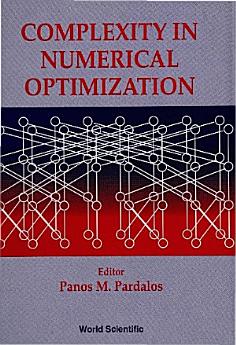Complexity In Numerical Optimization
জুলাই ১৯৯৩ · World Scientific
ইবুক
528
পৃষ্ঠা
family_home
যোগ্য
info
reportমূল্যাংকন আৰু পৰ্যালোচনা সত্যাপন কৰা হোৱা নাই অধিক জানক
এই ইবুকখনৰ বিষয়ে
Computational complexity, originated from the interactions between computer science and numerical optimization, is one of the major theories that have revolutionized the approach to solving optimization problems and to analyzing their intrinsic difficulty.The main focus of complexity is the study of whether existing algorithms are efficient for the solution of problems, and which problems are likely to be tractable.The quest for developing efficient algorithms leads also to elegant general approaches for solving optimization problems, and reveals surprising connections among problems and their solutions.This book is a collection of articles on recent complexity developments in numerical optimization. The topics covered include complexity of approximation algorithms, new polynomial time algorithms for convex quadratic minimization, interior point algorithms, complexity issues regarding test generation of NP-hard problems, complexity of scheduling problems, min-max, fractional combinatorial optimization, fixed point computations and network flow problems.The collection of articles provide a broad spectrum of the direction in which research is going and help to elucidate the nature of computational complexity in optimization. The book will be a valuable source of information to faculty, students and researchers in numerical optimization and related areas.
এই ইবুকখনক মূল্যাংকন কৰক
আমাক আপোনাৰ মতামত জনাওক।
পঢ়াৰ নির্দেশাৱলী
স্মাৰ্টফ’ন আৰু টেবলেট
Android আৰু iPad/iPhoneৰ বাবে Google Play Books এপটো ইনষ্টল কৰক। ই স্বয়ংক্রিয়ভাৱে আপোনাৰ একাউণ্টৰ সৈতে ছিংক হয় আৰু আপুনি য'তে নাথাকক ত'তেই কোনো অডিঅ'বুক অনলাইন বা অফলাইনত শুনিবলৈ সুবিধা দিয়ে।
লেপটপ আৰু কম্পিউটাৰ
আপুনি কম্পিউটাৰৰ ৱেব ব্রাউজাৰ ব্যৱহাৰ কৰি Google Playত কিনা অডিঅ'বুকসমূহ শুনিব পাৰে।
ই-ৰীডাৰ আৰু অন্য ডিভাইচ
Kobo eReadersৰ দৰে ই-চিয়াঁহীৰ ডিভাইচসমূহত পঢ়িবলৈ, আপুনি এটা ফাইল ডাউনল’ড কৰি সেইটো আপোনাৰ ডিভাইচলৈ স্থানান্তৰণ কৰিব লাগিব। সমৰ্থিত ই-ৰিডাৰলৈ ফাইলটো কেনেকৈ স্থানান্তৰ কৰিব জানিবলৈ সহায় কেন্দ্ৰত থকা সবিশেষ নিৰ্দেশাৱলী চাওক।







